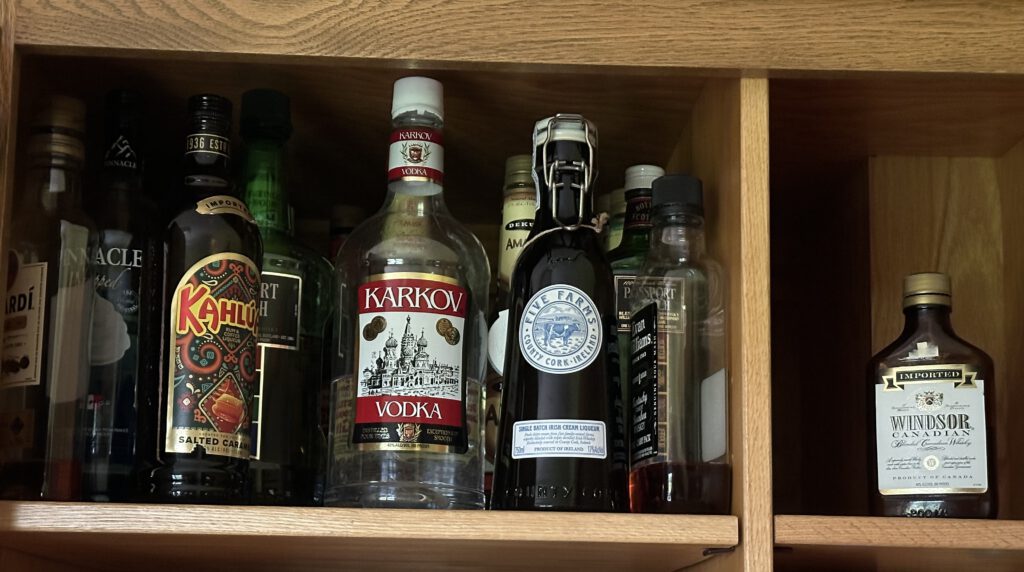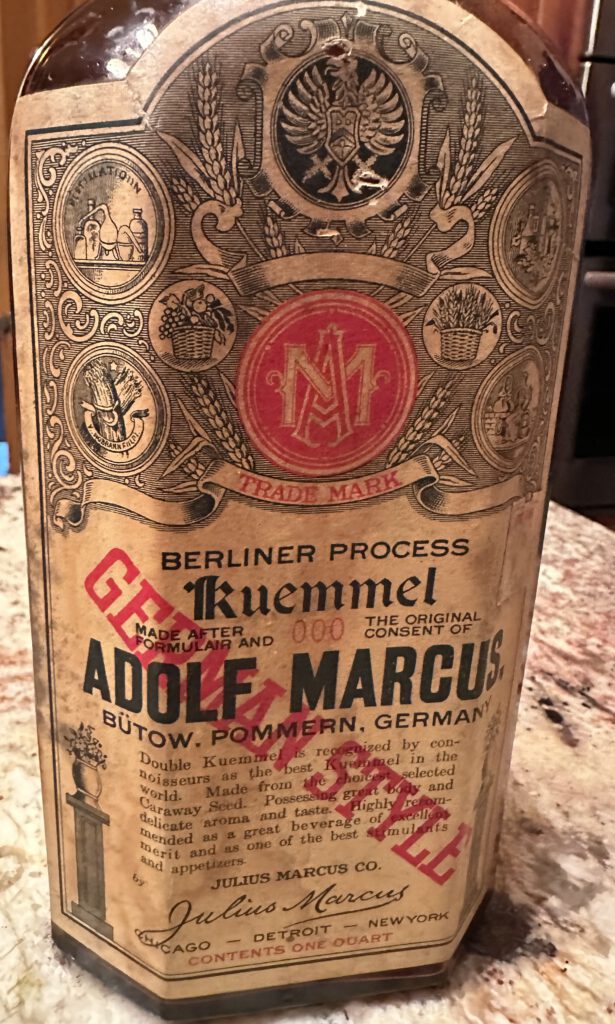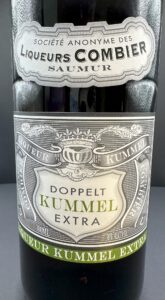“Spell it Kümmel or Kuemmel, but pronounce it Kimmel.”
Wausau Daily Herald, 14 September 1934
A mystery in the liquor cabinet?
Two of the sons and a daughter-in-law helped moved their parents from their house of forty years to an independent living apartment. The house was filled with things acquired in the first 64 years of the parents’ marriage. Squatting in the empty house for a few days after the move, the sons were left to deal with the contents of the liquor cabinet. Cocktails at the end of the day were appreciated. The third brother stopped for a night to pick up some things destined for his home and joined in the alcohol-removal task.

Some of the liquors were well past well aged.
The most interesting bottle was a mystery.

Kuemmel. What is kuemmel?
According to the internet, Kuemmel (or kümmel or kummel) is a sweet liqueur flavored with caraway and cumin seeds.
Wikipedia explains that it has been around since it was first distilled in the Netherlands in 1675. From there it gained popularity in Russia and Germany and beyond. By the mid-19th century, it was the rival of gin. The caraway seeds give it a calming effect and it has been touted as having the ability to reduce flatulence and bloating normally experienced after a heavy meal.1
Interesting.
We had never heard of the stuff.
How does it taste?
Adventurous drinkers, they could not NOT try it.
Following the suggestion on the back of the bottle, they added some water to the black syrupy substance that they found in the bottle. It did not turn clear. It remained black. It is supposed to be clear like gin. It was not. That did not prevent it from being tasted. It was described as the most sickening sweet thing ever tasted.
Not drinkable. Bummer.

But where did this bottle come from?
Since the label is in English, we know that it was bought in the United States and not brought back from a trip to Europe.
Since the bottle is a quart bottle we know that it was from before 1979-80. According to Wikipedia, “In 1975, the Bureau of Alcohol, Tobacco and Firearms, in cooperation with the Distilled Spirits Council of the United States, proposed metric-standard bottled sizes to take effect in January 1979, with a one-year changeover period in which both sets of sizes were legal…”2
The parents moved to this house in 1984, so that means the bottle was moved from their previous residence.
What clues does the bottle give?
Julius Marcus Co.
The manufacturer was listed as Julius Marcus Co.
In 1899, Julius Marcus was known as a wine merchant when the Brooklyn Eagle reported on an incident at the Long Beach Hotel in Long Island, New York. They reported that Mr. Marcus and his family were guests at the hotel. Marcus noticed some “valuable shirt studs” missing from his room so reported the loss to the chief hotel clerk. The clerk was rude and there were angry words between the two men. Marcus walked away. The clerk followed him to the piazza where he made a remark about Mrs. Marcus who was an invalid and had been summering at the hotel. “This so angered Mr. Marcus that he slapped the clerk in the face. This started the row in earnest and the clerk retaliated with several heavy blows, one of which knocked the Manhattan merchant down and cut his head open.”3
Kuemmel in Wausau
Since the sons’ maternal grandparents were teetotalers it seems probable that the bottle came from the paternal grandparents in Wausau, Wisconsin. If that is true, it probably came into this household after the death of Norman Krueger in 1980. It is also possible that the bottle was originally owned and enjoyed by Norman’s in-laws, Fred and Alice Aschbrenner.
A sticker on the bottle confirmed that it was purchased in Wausau. The sticker said “The Fair.” The Fair was a department store in Wausau, and a 1925 ad confirmed they sold Kuemmel.4

German Style
Our bottle of Kuemmel was identified as German Style. It was probably popular primarily in places with large numbers of people with German heritage – like Wausau. However, during WWI, Kuemmel lost popularity. Waiters in Chicago boycotted serving “Hindenburg” Kümmel since it was dedicated to the German general.5
Prohibition
We know the bottle could not have been purchased legally between 1920 and 1933 due to prohibition. When a Merrill, Wisconsin, couple’s home was raided by dry agents in 1932, Kuemmel was among the illegal substances found. The couple also had some whisky and home brew beer.6
During that time, the Julius Marcus Co. made non-alcoholic cordials. They incorporated in Brooklyn as Julius Marcus Laboratories in 1928 as a maker of food products.7
Julius Marcus Co. had some troubles with their prohibition era and later products. In October 1931, Julius Marcus Laboratories was the defendant in a case brought in Massachusetts. Seizures of Marcus fruit extracts had happened in Massachusetts in May and July 1930. In May 1934, bottles of their products, including Kuemmel, were found to be misbranded.8 9 10
Repeal
In 1933 Allied Brewing and Distilling Company, Inc. owned The Julius Marcus Laboratories, Inc. of Brooklyn, N.Y. and ran it as one of its divisions.11 They celebrated the repeal of prohibition.12
By 1934, Kuemmel was legally back on the market. In the Wausau Daily Herald, the “Mistletoe” brand of Kümmel was advertised as “a great favorite as a straight drink and as a cordial after dinner.”13

In 1935, a South Carolina newspaper ran an ad featuring a photo of a bottle that looks to be the same as our bottle.14

An article in the Detroit Free Press in March 1939 reported that the Julius Marcus Co., Inc. of New York City had been acquired by Arrow Distilleries, Inc. of Detroit. The article further reported that the New York plant was being closed and that the Marcus company had been nationally known in the field since 1885.15 Since the label lists Chicago, Detroit, and New York, our bottle of Kuemmel was manufactured prior to the New York plant closing, so likely before 1939.
Probably Norman’s?
Norman and Sally Krueger married just ahead of the repeal of prohibition so they were most likely the original owners. The bottle was likely purchased at The Fair department store in Wausau between 1934, when it was legal to own liquor again, and shortly after 1939 when the Julius Marcus company was sold and their factory closed.
That 1930s bottle would have been moved from house to house in Wausau and then eventually moved to at least a couple houses of their son in Minnesota. Ninety or so years later, the empty bottle is now on a shelf of a grandson of Norman and Sally and will be a good conversation starter for years to come.
New Kuemmel
While the bottle found in the liquor cabinet was no longer drinkable, Kuemmel is still made.
Guess what we had after Thanksgiving dinner this year?


With the Krueger clan assembled, we told the story of finding the bottle to those who hadn’t heard it and then poured a taste.
Their thoughts…
“Pleasant, sweet. Maybe good with tonic water? 8/10,” EJK.
“Much ‘brighter’ than typical liquor,” JFK
“Sweet flavor. Bright. Slightly floral. Fennel finish. Bright citrus aroma. Very pleasant overall. I like it! I’ll take a bottle,” BPK
“It has a nice warming effect in the throat like schnapps but not as harsh. I have never tasted any liquor like it before,” JNK
“It is very sweet, syrupy with a finish of caraway seeds,” ENBK
“Sweet, with a bit of a sensation on the tongue,” TJK
“It’s a good stimulant and appetizer,” CMPK
“Starts floral with some citrus and ends like you’ve eaten some good rye bread. Nice & light. Really interesting. Now I understand the rye ice cream I had in Iceland!,” RCSK
“It’s very flavorful and I can imagine using it in many ways. It is a bit much on its own though. Would be very good with tonic or elderflower soda – probably anywhere gin would be good.” CMK II
“8.2/10. Fennel. Sweet, aromatic, citrusy. A bit like rumplemintz if it wasn’t minty, and less alcohol content.” IJK
“Rye bread. Syrupy – thick. Cumin on the nose but not in the mouth.” CJK
Originally I thought maybe we should take some time to clean out our own liquor cabinet before the kids have to do it. But this was a fun family activity, so maybe not.
Cheers to Kuemmel!
Sources:
- “Kummel (liqueur),” Wikipedia. https://en.wikipedia.org/wiki/K%C3%BCmmel_(liqueur) : accessed 01 Aug 2024. ↩︎
- “Fifth (unit),” Wikipedia. https://en.wikipedia.org/wiki/Fifth_(unit)# : accessed 01 Aug 2024. ↩︎
- 1899. “Row At Long Beach Hotel, Julius Marcus, a Wealthy Guest, Knocked Down and Slapped by the Chief Clerk,” 14 Aug: 02. Brooklyn Eagle (Brooklyn, New York) https://www.newspapers.com/image/50387542/?match=1&terms=Julius%20Marcus : accessed 04 Aug 2024. $ ↩︎
- “July Look Clearance Specials,” 16 Jul: 02. Wausau Daily Herald (Wausau, Wisconsin) https://www.newspapers.com/image/272612107/ : accessed 01 Dec 2024. $ ↩︎
- 1917. “Waiters Boycott Hindenburg Liquor,” 13 Jun: 08. Wausau Daily Herald (Wausau, Wisconsin) https://www.newspapers.com/image/272384858/ : accessed 01 Aug 2024. $ ↩︎
- 1932. “Seventeen Places At Merrill Wiped Up By Dry Agents,” 17 Sep: 04. Wausau Daily Herald (Wausau, Wisconsin) https://www.newspapers.com/image/272919613/ : accessed 01 Aug 2024. $ ↩︎
- 1928. “New Incorporations,” 25 Jul: 33. The Brooklyn Daily Times (Brooklyn, New York) https://www.newspapers.com/image/558549706/?match=1&terms=Julius%20Marcus%20Laboratories : accessed 04 Aug 2024. $ ↩︎
- “18164. Adulteration and misbranding of raspberry, strawberry, grape, and cherry extracts. U.S. v. 9 Dozen Bottles of Raspberry Extract, et al. Default decrees of condemnation, forfeiture, and destruction,” NIH National Library of Medicine https://fdanj.nlm.nih.gov/catalog/fdnj18164 : accessed 04 Aug 2024. ↩︎
- “18165. Adulteration and misbranding of fruit beverage materials. U.S. v. Certain Quantities of Fruit Beverage Materials. Default decree of condemnation, forfeiture, and destruction,” NIH National Library of Medicine https://fdanj.nlm.nih.gov/catalog/fdnj18165 : accessed 04 Aug 2024. ↩︎
- “22774. Misbranding of kummel and liqueurs. U.S. v. 15 Bottles of Kummel. et al. Default decree of condemnation, forfeiture, and destruction,” NIH National Library of Medicine. https://fdanj.nlm.nih.gov/catalog/fdnj22775 : accessed 03 Aug 2024. ↩︎
- 1933. “112,500 Shares Allied Brewing and Distilling Company,” 27 Jun: 15. The Indianapolis Star (Indianapolis, Indiana) https://www.newspapers.com/image/105235746/ : accessed 04 Aug 2024. $ ↩︎
- 1933. “Repeal! How will repeal affect Common Stock of the Allied Brewing & Distilling Co.,” 02 Oct: 11. The Indianapolis Star (Indianapolis, Indiana) https://www.newspapers.com/image/873261139/ : accessed 01 Aug 2024. $ ↩︎
- 1934. “Get Acquainted with Kümmel,” 14 Sep: 02. Wausau Daily Herald (Wausau, Wisconsin) https://www.newspapers.com/image/272999180/ : accessed 01 Aug 2024. $ ↩︎
- 1935. “Announcing The Finest Line of Cordials in South Carolina and all of the U.S.A.! Liqueurs by the House of Julius Marcus,” 08 Jul: 10. The State (Columbia, South Carolina) https://www.newspapers.com/image/748654862/ : accessed 01 Aug 2024. $ ↩︎
- 1939. “Arrow Distilleries Acquires Marcus Co.,” 25 Mar: 19. Detroit Free Press (Detroit, Michigan) https://www.newspapers.com/image/97649743/ : accessed 01 Aug 2024. $ ↩︎


Leave a Reply